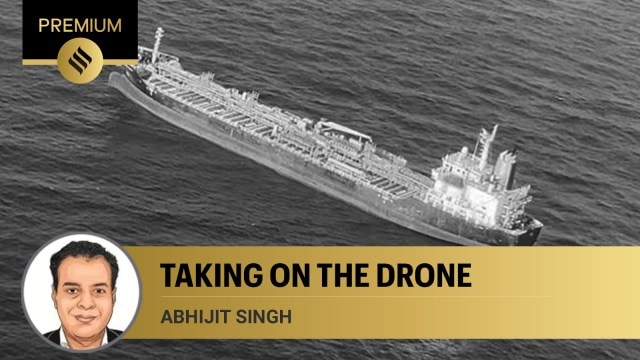- India
- International
Drone strike in Arabian sea: A new challenge for the Navy
Even if the time is ripe for India to act on the attack by Houthis, the question is: How? Anti-drone warfare is complex and few navies have the means to effectively combat air-and-sea-borne drones.
 Visual of the merchant ship MV Chem Pluto taken by the Indian Coast Guard’s Dornier maritime surveillance aircraft in the Arabian Sea after it was hit by a suspected drone. (X/ANI)
Visual of the merchant ship MV Chem Pluto taken by the Indian Coast Guard’s Dornier maritime surveillance aircraft in the Arabian Sea after it was hit by a suspected drone. (X/ANI)In the early evening of December 23, the United Kingdom Merchant Traffic Organisation, the principal point of contact for merchant vessels and liaison with military forces in the Western Indian Ocean, reported a suspected armed drone strike on a merchant ship 200 miles off the Porbandar coast. The MV Chem Pluto, a Liberia-flagged chemical tanker with a crew of 20 Indians, was reportedly on its way from Saudi Arabia’s Jubail port to New Mangalore when it was hit by an unmanned aerial vehicle, triggering a massive fire onboard.
The incident caused a stir in India’s security establishment. No sooner had the drone hit been reported than New Delhi dispatched an Indian Coast Guard vessel and an Indian warship to the site of the attack. The Indian Navy, like other regional navies, has rarely, if ever, had to deal with drone attacks on civilian ships. Maritime forces in the Indian Ocean are adept at fighting pirates, but many navies, including the IN, are unaccustomed to dealing with such radical militant tactics as those employed by the Houthis. The Iran-backed group has been carrying out aerial drone bombings and missile attacks on civilian shipping. Hours after the attack in the Arabian Sea, the Houthis carried out another drone strike on a Gabon-flagged crude oil tanker in the Southern Red Sea. Crucially, the targeted vessel has no connections to Israel, which many interpret as an indication of the militants’ growing desperation.
In a way, the escalation in violence was to be expected. The pressure on maritime forces in the Western Indian Ocean has been building since mid-November when the Houthis released a video of a raid on a cargo vessel in the Red Sea with reported Israeli links. Militant assaults on commercial shipping have since steadily increased. To protect regional maritime traffic, the US announced Operation Prosperity Guardian last week, with the support of allies and partners, including the UK, Bahrain, Canada, Netherlands, Norway, and Seychelles. As if in response, the militants have widened their choice of targets and theatre of operations.
The scenario poses a dilemma for India. New Delhi is keen to contribute to the US-led endeavour but ostensibly wary of taking on the Houthis, who are, by all accounts, capable combatants. Before the Chem Pluto incident, Indian warships on anti-piracy duties in the Gulf of Aden appeared to have avoided the conflict zone in the Southern Red Sea. A drone attack on a commercial ship in the Arabian Sea, however, significantly alters India’s calculus. Indian observers are likely to see this attack as a sign that the Houthis are capable and willing to strike their enemies anywhere in the Indian Ocean. Many are likely to argue that the attack creates an imperative for India to join the US-led coalition. They may be right unless Washington’s claim — however implausible — that the attack on the MV Chem Pluto came from Iran is proven correct, in which case New Delhi may need to revisit its calculus.
Even if the time is ripe for India to act, the question is: How? Anti-drone warfare is complex, and few navies have the means to combat air-and-sea-borne drones effectively. The only effective technologies for defence against aerial drone attacks are jamming and spoofing, but these are unavailable to merchant ships. To complicate matters, many anti-drone techniques are not known to work well in particular weather conditions. Jamming, in particular, is tricky as it has the potential to interfere with friendly communication systems. Spoofing, too, while useful for confusing drone control systems, often leads to the target behaving erratically. Directed energy weapons such as laser systems and high-power microwave weapons are more effective in countering armed drones, but these technologies are expensive and out of reach for most regional navies.

The only viable option for India, then, might be to join the US-led coalition. The IN recently became a full member of the Combined Maritime Forces and has exercised with coalition navies in the Western Indian Ocean. Of the five task forces the CMF operates, Combined Task Force 153 — in charge of security in the Red Sea — is likely to lead Operation Prosperity Guardian. As part of the coalition, the IN could help create a safe transit corridor stretching out from the Southern Red Sea to the Gulf of Aden and beyond.
The Houthis would, of course, seek to exploit the complex geopolitics of the Israel-Palestine conflict to thwart the opposition. Already, disagreements within the coalition have led France, Italy, and Spain to pull out. The militants are likely to take advantage
of the differences among major maritime powers to venture further afield into undefended areas in the Indian Ocean, such as the Arabian Sea.
India’s naval commanders know that fighting the Houthis won’t be easy. The tactics of anti-drone warfare at sea are still evolving, and some methods of targeting drones are reportedly not as effective as commonly believed. In the past few weeks, the USS Carney has claimed to have shot down 14 armed drones in the Red Sea. It is yet unknown what weapons were used, but it is likely a long-range gun that was employed in combination with missiles. The only thing that can be said with certainty is that overcoming the Houthi challenge will require improvisation, operational coordination, and a high order of interoperability between coalition partners.
While the IN is still in the process of acquiring counter-drone systems, India’s front-line guided missile destroyers — four of them presently deployed in the Arabian Sea — have the necessary sensors to detect aerial drones. Even so, actively countering armed drones will require the IN to work alongside more capable partners. This applies equally to other maritime forces in the region. Better situational awareness and better tools to tackle drone attacks are the need of the hour. At a minimum, navies will need to change mindsets, step out of their comfort zones, and up their operational game in the littorals.
The writer is Head of the Maritime Policy Initiative at ORF, New Delhi
40 Years Ago
EXPRESS OPINION
Must Read
More Explained
May 14: Latest News
- 01
- 02
- 03
- 04
- 05









































